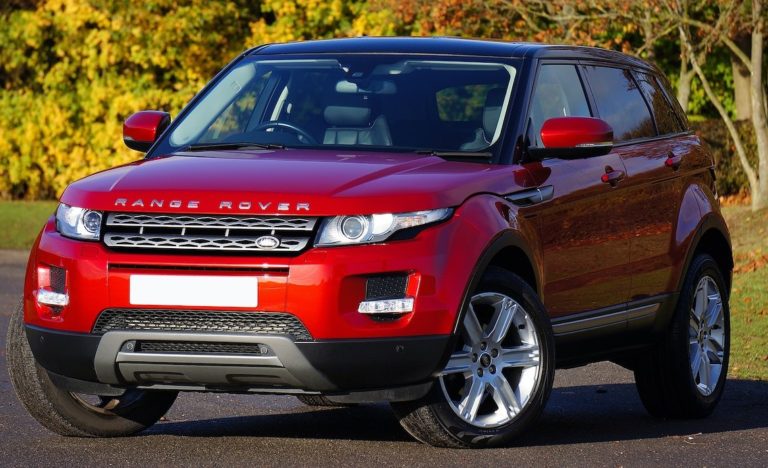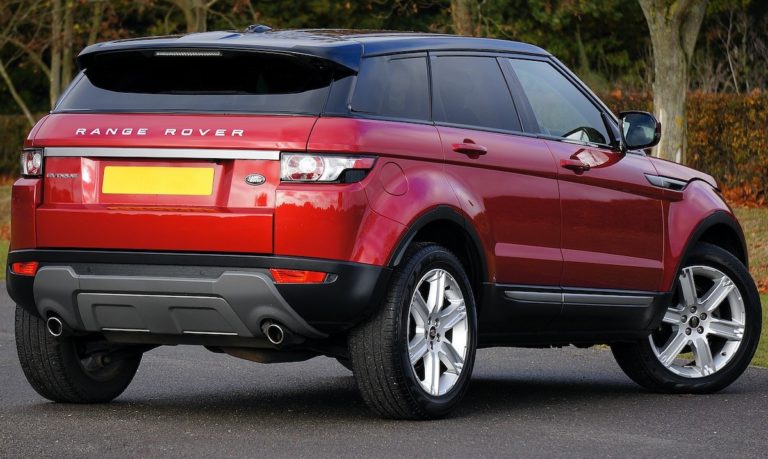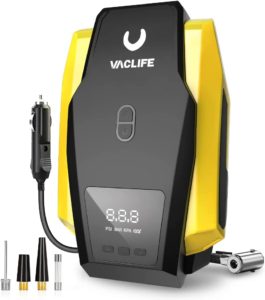Steps to Reset Range Rover Evoque TIre Pressure Light
Step 1: Check and Adjust the Tire Pressure
Your Range Rover Evoque does not have a tire pressure reset button like every other website says. All you actually have to do is set your tire pressure to the exact pressure that Range Rover recommends. Follow the sequence below to find out what your current tire pressure is and what it’s supposed to be. (recommended pressure is in parenthesis)
Turn the ignition on
Press the menu button on the steering wheel
Scroll down and select service menu
Select tire pressure check
Make sure you check your tire pressures when your tires are cold. This means before driving a long distance or after the car has been sitting for a few hours.
Step 2: Drive Your Range Rover Evoque
Once you have set your tire pressures to the correct levels, drive your Range Rover Evoque! Drive at least 15 Mph for 5 minutes. If the tire light doesn’t go off, keep driving.
Step 3: Re-Check Your Tire Pressure
If the tire pressure light doesn’t go off after step 1 and step 2, double check your tire pressure. Make sure that the pressure is still at the exact pressure you set it to. If it’s not, you likely have a tire leak or some sort of puncture. If the tire light goes off and then comes back on, you definitely have a tire leak. If the light flashes or blinks and then stays on, you have a TPMS malfunction. Read the section on TPMS Malfunction to learn more about what it means.
2023 Range Rover Evoque Tire Pressures
Trim Model | Tire Size | Light Load Inflation Front/Rear | Normal Load Inflation Front/Rear |
Range Rover Evoque | 235/60R17 | 35 PSI/32 PSI | 37 PSI/38 PSI |
Range Rover Evoque | 235/60R18 | 35 PSI/32 PSI | 38 PSI/40 PSI |
Range Rover Evoque | 235/50R20 | 37 PSI/35 PSI | 44 PSI/43 PSI |
Range Rover Evoque | 245/45R21 | 37 PSI/34 PSI | 44 PSI/43 PSI |
Range Rover Evoque | SPARE TIRE | 60 PSI | 60 PSI |
How To Check and Adjust Your Tire Pressure
Take off the tire valve cap.
Securely connect a tire pressure gauge and/or inflator to the valve.
Check the tire pressure on the gauge and inflate as needed.
When using a manual gauge to add air, detach and reconnect it before taking a pressure reading to ensure accuracy.
Replace the valve cap.
Other Range Rover Evoque Features
To Change Pressure Monitoring Units
Select menu
Select service menu
Select tire pressure monitor
Select pressure display units
Choose between Psi, Bar, and kPa
To Change Pressure Load Settings
Select menu
Select service menu
Select tire pressure monitor
Select TPM load setting
Select Heavy load or Light load.
All the steps above are applicable to all Range Rover Evoque trims and models from 2011-2024.
Range Rover Evoque TPMS Malfunction Indicator
Your Range Rover Evoque comes with a TPMS malfunction indicator that alerts you when the system isn’t working properly. This indicator uses the same dashboard light as the low tire pressure alert, but it has a different function. (Yes, the same annoying yellow exclamation point!) If the TPMS isn’t working properly, the warning light will flash for around 75 seconds before staying lit continuously. This pattern will repeat every time you start the car until the problem is fixed. Basically, your tire pressure monitoring system won’t work correctly until the problem with the TPMS is fixed. Usually this means you have a bad or faulty tire pressure sensor. In other words, if you have a blinking tire pressure light, you have a problem with the TPMS system itself, not an air pressure problem. To determine which tire sensor is the problem, you will need a TPMS diagnostic tool to scan each sensor and find the bad one. This is the one I use.
When Should You Reset Your TPMS?
After replacing a TPMS sensor
After changing or rotating tires
After installing new wheels or tires
After experiencing a flat tire and repairing or replacing it
After changing the tire pressure to meet seasonal or load requirements
After receiving a TPMS warning/alert on the dashboard
After a significant temperature change that could affect tire pressure
After having a tire puncture repaired or patched
If the TPMS system is not properly functioning or providing accurate readings
As part of your regular vehicle maintenance schedule
How Range Rover Evoque TPMS Works
TPMS Components
a. Tire pressure sensors: These are located inside each tire, integrated with the valve stem. They measure the air pressure and temperature of the tire.
b. TPMS control module: This is the central processing unit that receives information from the tire pressure sensors and communicates with other vehicle systems.
c. TPMS warning light: Located on the instrument cluster and infotainment system, this light illuminates when there is a problem with your tire pressure. This is that annoying yellow exclamation point we all love.
d. TPMS display: The Range Rover Evoque shows individual tire pressure readings.
Tire Pressure Monitoring Process
a. The tire pressure sensors continuously measure the air pressure and temperature within each tire.
b. The sensors transmit this data wirelessly to the TPMS control module constantly.
c. The control module processes the data and compares it to the recommended tire pressure values stored in its memory.
d. If any tire’s pressure is outside the acceptable range, the TPMS control module triggers the TPMS warning light.
What Causes the TPMS Light to Turn On?
Low Tire Pressure
Natural air loss over time
Temperature fluctuations causing pressure changes
Slow leaks due to punctures or damaged valve stems
Incorrect tire inflation during maintenance
High Tire Pressure
Overinflation during maintenance
Temperature increases causing pressure changes
Sensor-related Issues
Damaged or malfunctioning tire pressure sensor
Dead or weak sensor battery
Sensor signal interference from nearby electronics or other devices
Corrosion or debris affecting sensor function
TPMS Control Module Issues
Malfunctioning TPMS control module
Outdated software in the control module
Poor communication between sensors and control module
Control module not programmed with correct tire pressure values
TPMS Warning Light Malfunctioning
Faulty TPMS warning light or circuitry
Instrument cluster malfunction
Other Tire-Related Issues
Rapid loss of tire pressure due to a blowout or severe puncture
Wheel installed without tire pressure sensor
Incorrect tire size or type installed on the vehicle
Maintenance and Installation Errors
Failure to reset the TPMS system after tire rotation or replacement
Incorrectly installed or incompatible aftermarket sensors
Damaged sensors during tire service or replacement
How the Weather Affects your Tire Pressure
Check out this line chart that illustrates the relationship between outside temperature and tire pressure, using both Fahrenheit and Celsius, as well as PSI and kPa units. You’ll notice that when it gets colder, tire pressure typically drops, and conversely, it rises as the temperature climbs. It’s best to measure tire pressure at about 62°F (16.7°C), as it remains pretty stable at that point. In a nutshell, for every 10-degree decrease in temperature, you can expect your tire pressure to drop by roughly 1 PSI.
The Benefits of Range Rover Evoque TPMS
The Range Rover Evoque’s TPMS (Tire Pressure Monitoring System) is a fantastic feature that offers several key benefits to enhance your driving experience. By continuously monitoring tire pressure, it helps ensure optimal vehicle performance, improves fuel efficiency, and prolongs tire life. This smart system not only alerts you of any tire pressure issues but also contributes to your safety on the road. So, with Evoque’s TPMS, you can enjoy peace of mind knowing your vehicle is running efficiently and safely, all while minimizing your environmental impact and saving money on fuel and tire replacement costs.
Please note that this blog post contains Amazon affiliate links. This means that if you make a purchase through one of these links, we at TPMSRESET.com may earn a small commission at no extra cost to you. We only recommend products that they personally use and believe in. Thank you for supporting this blog.




